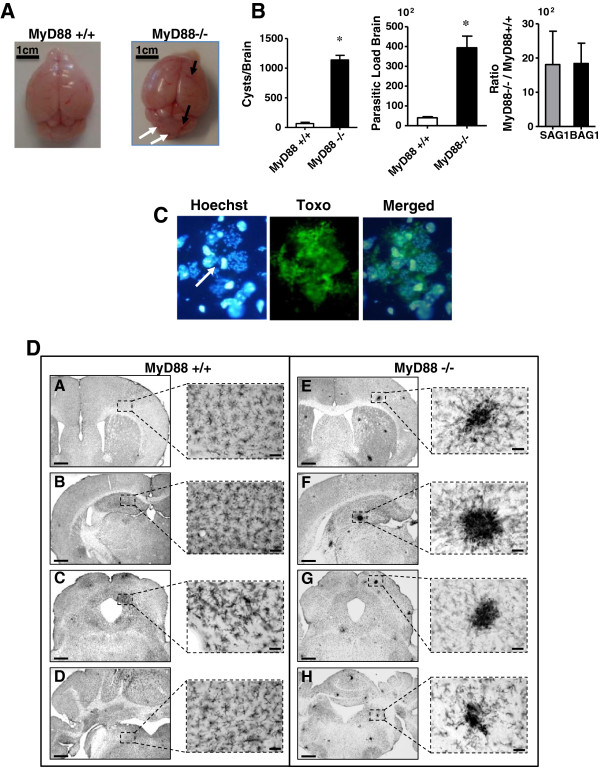Figure 4.
The particular case of the brain. (A) Macroscopic observation of the brains of MyD88−/− and MyD88+/+ mice infected with 80 cysts of the 76 K T. gondii strain 13 days postinfection. Brains from MyD88−/− mice revealed distinct hemorrhagic (black arrows) and necrotic areas (white arrows), differing substantially from MyD88+/+ controls. (B) Thirteen days postinfection, mice from both genotypes were sacrificed and their brains were removed to analyze parasite loads after brain homogenization by microscopic counting (left graph), by qPCR (middle graph), and by qRT-PCR to analyze expression of bradyzoite (BAG1) and tachyzoite (SAG1) mRNA (right graph). The results are presented as the ratio of the expression level in MyD88−/− mice to the expression in MyD88+/+ mice. The data were statistically analyzed using the Mann–Whitney U test (GraphPad Prism software), * (P <0.05). The results are representative of four independent experiments with n = 7 mice. (C) Immunofluorescence staining of Toxoplasma gondii tachyzoites in the brain of MyD88−/− mice. Frozen brain sections were stained with a polyclonal rabbit anti-Toxoplasma, followed by a FITC-conjugated donkey anti-rabbit serum and counterstained with Hoechst to show nuclei. The arrow shows DNA parasite (x 100). (D) Microglia was stained using a CD11b antibody. (A) to (D): microphotographs of the wild-type MyD88+/+ only showing ramified microglia and very few clustered ameboid microglia; (E) to (H): microphotographs of MyD88−/− brain sections showing numerous clustered ameboid and ramified microglia. (A) and (E): striatum and cortex areas; (B) and (F): hippocampal area; (C) and (G): periaqueductal gray and midbrain areas; (D) and (H): brainstem and cerebellum. The staining was repeated in two other mice in each group with similar staining. Bar = 500 μm left column, bar = 50 μm right column. FITC, fluorescein isothiocyanate; qPCR, real-time polymerase chain reaction; qRT-PCR, real-time reverse-transcription polymerase chain reaction.

